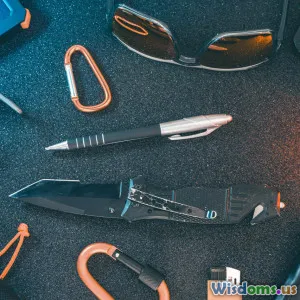
Pros and Cons of Leading Brands in Compact Survival Gear
8 min read Explore the pros and cons of top brands in compact survival gear to make informed choices for your outdoor adventures. (0 Reviews)
Pros and Cons of Leading Brands in Compact Survival Gear
When it comes to survival gear, especially compact survival tools, choosing the right brand can be the difference between life and death, comfort and hardship in the wilderness. Surviving in harsh conditions requires reliable equipment that not only fits easily into your pack but also stands up to extreme environments. This article delves into the advantages and disadvantages of the leading compact survival gear brands, helping adventurers and survivalists make well-informed purchasing decisions.
Introduction
Imagine being stranded in the wilderness with only a compact survival kit in your backpack. The gear you have at hand will dictate how well you adapt and overcome challenges—from shelter building to food procurement and navigation. But with an overwhelming variety of brands available, how do you determine which offers the best mix of reliability, innovation, and value?
Compact survival gear is designed to be lightweight and space-efficient, making it ideal for hikers, campers, preppers, and survival experts. However, the diverse product offerings from the leading brands come with distinct pros and cons that influence how suitable they are for different survival scenarios.
Top Brands in Compact Survival Gear and Their Strengths
1. Leatherman
Leatherman is arguably the defining brand for multi-tools and compact survival equipment. Founded in 1983, it revolutionized pocket tools by integrating pliers, knives, screwdrivers, and more into sleek, portable devices.
Pros:
- Durability: Leatherman tools are made with stainless steel, designed to withstand brutal use.
- Versatility: Their multi-tools often combine 15+ functions, from wire cutting to can opening, reducing the need for multiple items.
- Warranty and Support: Backed by a 25-year warranty and excellent customer service.
Cons:
- Weight: Though compact, their tools can be heavier compared to ultra-light competitors.
- Price: High-quality craftsmanship comes at a premium.
Example: The Leatherman Wave Plus is popular among survivalists for its robust build and multiple tool options.
2. Gerber Gear
Gerber focuses heavily on survival knives, fixed blades, and multi-tools designed with tactical and outdoor use in mind.
Pros:
- Affordability: Offers competitive pricing without substantial loss in quality.
- Specialized Design: Some tools are optimized for specific tasks like hunting or tactical rescue.
- Variety: Broad product line from fixed blades to compact survival kits.
Cons:
- Longevity: Some users report dulling blades quicker than higher-end brands.
- Ergonomics: Certain models are bulkier and less user-friendly in tight spaces.
3. Survival Frog
A relatively newer entrant, Survival Frog has positioned itself as a go-to brand for comprehensive survival kits.
Pros:
- Package Deals: Bundled survival kits that cater to various emergency scenarios.
- Innovative Items: Includes fire-starting tools, water purification, and compact fishing gear.
- Customer Testimonials: Majority praise quick delivery and quality packaging.
Cons:
- Component Quality: Individual items sometimes lack the durability found in standalone branded gear.
- Bulk: Some kits are larger, challenging the notion of 'compact' survival gear.
4. SOG Specialty Knives & Tools
SOG is well-known for innovative blade designs and tactical multi-tools that are compact yet efficient.
Pros:
- Innovation: Patented blade mechanisms like assisted opening for rapid deployment.
- Material: Uses high-grade stainless steel and carbon fiber for strength and weight saving.
- User-Friendly: Ergonomic grips designed to reduce hand fatigue.
Cons:
- Pricey: Advanced technologies come with steep costs.
- Maintenance: Some models require specific sharpening techniques to maintain blades.
Comparing Performance and User Feedback
When evaluating these brands, outdoor experts often emphasize the balance between tool versatility, durability, size, and price. For example, an experienced survivalist might prefer Leatherman’s heavy-duty tools for extended expeditions. In contrast, a casual hiker may find Gerber’s affordable options sufficient for shorter trips.
User reviews on platforms such as REI, Amazon, and outdoor forums highlight trends:
- Leatherman’s endurance and repairability are praised by military personnel and long-term survivalists.
- Gerber appeals to budget-conscious adventurers but sometimes lacks in blade retention over time.
- Survival Frog kits cater excellently to beginners wanting ready-to-go solutions, although some gear may need upgrading.
- SOG’s craftsmanship satisfies tactical users who value innovation over price.
Additionally, field tests by survival experts simulate real-world conditions, revealing crucial insights:
"In extreme weather tests, Leatherman tools showed remarkable resistance to rust and joint stiffness, a vital trait for wet environments." - Outdoor Gear Lab
"SOG’s assisted-opening blades excelled in emergency scenarios requiring quick weapon deployment." - Tactical Survival Magazine
What to Consider When Choosing Compact Survival Gear
- Weight and Size: Essential for mobility. A bulky tool can deter use and add unnecessary fatigue.
- Functionality: Multi-purpose tools reduce kit bulk but watch out for complexity impacting reliability.
- Durability: Materials like stainless steel or titanium enhance lifespan and performance under stress.
- Ease of Maintenance: Tools that require minimal care are preferable in survival contexts where sharpening or replacements might be impossible.
- Customer Support and Warranty: Strong after-sales service adds security to investment.
Conclusion
Selecting compact survival gear from leading brands involves weighing trade-offs between cost, durability, functionality, and intended use. Leatherman stands out for its rugged multi-tools suited for long-lasting heavy use, while Gerber offers budget-friendly options appealing to beginners. Survival Frog provides all-in-one kits ideal for those who want complete setups, though component quality varies. SOG appeals with their innovative designs tailored toward tactical and expert users.
Ultimately, the best gear aligns with your specific survival needs, environment, and adventure style. Careful research, consideration of user reviews, and hands-on trials are invaluable steps before finalizing any purchase. Survival gear could become your lifeline—choosing wisely equips you not just for adventure, but for safety and preparedness in the wild.
Remember, the gear empowers your survival skills, but adaptability and knowledge remain your greatest assets.
References:
- Outdoor Gear Lab: Multi-tool Field Reviews (2022)
- Tactical Survival Magazine: Best Blades of 2023
- REI Customer Reviews - Leatherman and Gerber Products
- Survival Frog Product Manuals and Customer Feedback
Rate the Post
User Reviews
Popular Posts




















